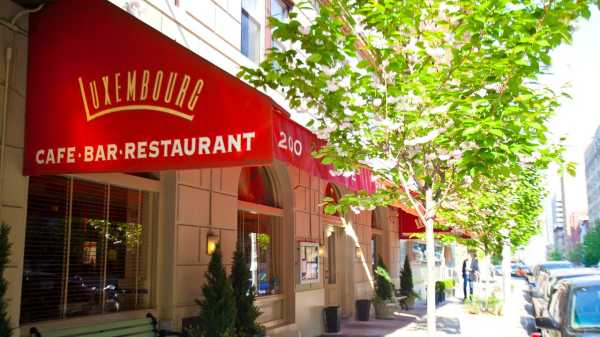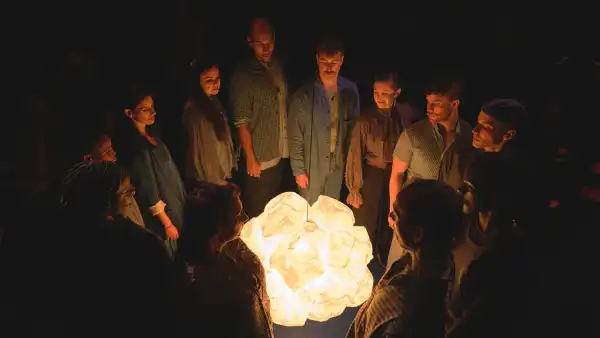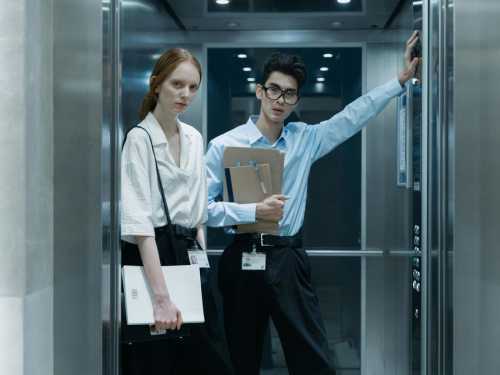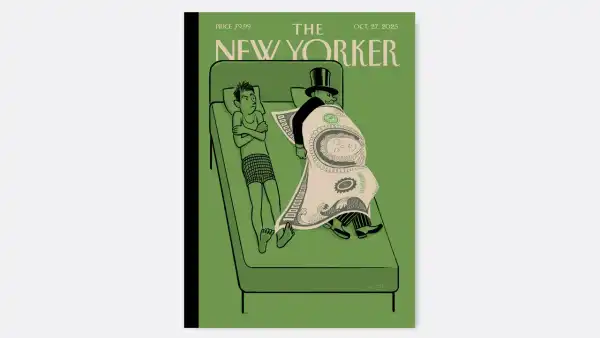
There is a scene from “When Harry Met Sally” set at Café Luxembourg, the Upper West Side restaurant, though it is hardly as iconic as the one in which Meg Ryan fakes an orgasm at Katz’s Deli. Harry and Sally are on a double date, trying to set each other up with their respective best friends. The vibes are off; the small talk is halting. But then Harry’s best friend, a writer played by Bruno Kirby, remarks that he thinks restaurants have become “too important” in modern society, and Sally’s friend, played by Carrie Fisher, agrees, and quotes something she read in a magazine: “Restaurants are to people in the eighties what theatre was to people in the sixties.” Kirby’s character is amazed, because he wrote that very line. The movie, written by Nora Ephron, captures the patter of certain New York types, both those who work in media and those who merely consume it obsessively. The talk feels lived-in, but so does the place, which looks fancy-ish but hardly stuffy: white tablecloths, vases bursting with flower arrangements, glasses of wine filled to the brim. Patrons sit close to one another in chairs with homey rattan backs.
Café Luxembourg turns forty years old this year, but it still looks and feels just as it did back then. Places to eat open and close every day in Manhattan. Greedy landlords double or triple the rent. Chefs burn out. Culinary tastes change. The places that manage to achieve longevity often do so because they offer customers something very specific and stick with it over time. If you sat down right now at Café Luxembourg, which is situated on an unassuming strip of West Seventieth off of Amsterdam Avenue, you’d find a restaurant that has stayed almost fanatically true to its bistro-influenced origins. The owner, Lynn Wagenknecht, recently told me that certain concessions to modernity have been made, including a partial update of the chairs. “Some had to be replaced,” she said. “But we still have a lot of the originals.” You can order a smaller piece of steak now, too, as what Wagenknecht called “a post-pandemic accommodation.” Thankfully, the accompanying fries still spill generously over the sides of a Belgian-style paper-wrapped cone.
Wagenknecht, who is “tiptoeing to seventy this year,” has pale-blue eyes and a friendly accent held over from her native Illinois. A restaurateur in New York City for more than four decades, she has shown a particular knack for maintaining businesses that seem only to get better with age. In 1980, when she opened the Odeon with her boyfriend at the time, Keith McNally, and his brother Brian, the place felt simultaneously fresh and classic. The mood was one part Parisian café and one part Raymond Chandler noir. The neon sign—famously depicted on the cover of Jay McInerney’s novel “Bright Lights, Big City”—called out to the rich and the almost-famous descending upon Tribeca when the neighborhood still retained a modicum of grit. If you could get a table, there was a chance you’d be dining next to Jean-Michel Basquiat and Madonna, David Hockney, or cast members of “Saturday Night Live.” Manhattan’s café society had previously been concentrated farther North—at Midtown stalwarts such as 21 Club or the Russian Tea Room, or on the Upper East Side at Elaine’s. The Odeon marked the scene’s migration downtown. So West Seventieth Street was a peculiar place for the city’s new restaurant power couple to choose for a follow-up.
What drew Wagenknecht and McNally to the neighborhood, according to Wagenknecht, were the repertory movie theatres, most of which haven’t survived as long as Café Luxembourg. Wagenknecht and McNally would trek from their home downtown to Thalia, on Broadway in the West Nineties, or the Carnegie Hall Cinema, in the same building as the concert hall, to see films by Alfred Hitchcock and Michelangelo Antonioni and the directors of the French New Wave. “We weren’t really familiar with that part of the city, but occasionally we’d want something to eat while we were still uptown,” Wagenknecht said. The neighborhood had long been the land of Barney Greengrass lox, eggs, and onions and the Gray’s Papaya “recession special”—two hot dogs and a tropical drink for under two bucks back then—or of neighborhood joints that were beloved by locals but didn’t rise to the level of destination dining. Wagenknecht knew of a place called L’Élyseé that a friend had opened with his French aunt. The business wasn’t doing so well, but the couple stopped in to eat, and the space showed promise. “Like the Odeon, it was sort of wider than it was deep,” Wagenknecht said—an anomaly in New York commercial real estate. And it turned out that the French aunt wanted to sell.
The question of who should run Café Luxembourg’s kitchen was simple. Patrick Clark, the chef at the Odeon, was a rarity in the culinary world at the time: a Brooklyn-born, European-trained Black man putting his own mark on Parisian bistro fare. He prepared dishes such as poached oysters with beurre blanc or veal sweetbreads and scallops in a champagne sauce. Anthony Bourdain wrote in his memoir “Kitchen Confidential” that Tribeca was “a neighborhood that seemed not to have existed until Patrick started cooking there.” When Café Luxembourg first opened its doors, in the summer of 1983, Wagenknecht said, the clientele was mostly “people we knew through the Odeon,” which might be underselling it a bit. Early coverage in the Times noted that “stretch limos are lined up outside,” and that Lorne Michaels, Warren Beatty, and Calvin Klein had already become regulars. The nineteen-eighties-Manhattan-by way-of-nineteen-thirties-Paris vibe was aided by the Deco-inspired interior design—blue- and cream-colored tile, arched mirrors—and by black-and-white Café Luxembourg postcards and advertisements featuring a trio of nude women with their backs to the camera and their backsides fully exposed.
Then as now, the Upper West Side seemed perpetually on the cusp of a culinary breakthrough. In a positive review of Café Luxembourg, Gael Greene complained that the area’s so-called renaissance had “provoked a plague of ptomaine guzzleries and only a scrimp of restaurants we dare to favor.” Some of the restaurants that would be heralded as signs of progress—Tom Valenti’s Ouest, the Michelin-starred Dovetail—have long since closed, and Café Luxembourg remains one of the more solid dining options you’ll find for blocks in every direction. West Seventieth Street is close enough to Midtown to feel a little bit of that area’s touristy back draft, but is still very much the land of Leonard Bernstein, Neil Simon’s “The Odd Couple,” private-school kids, and perhaps one out of every three grandparents in Manhattan. Wagenknecht described the crowd today as “mostly” locals, many of whom are regulars. “We have people who come in every day. Every lunch and sometimes lunch and dinner,” she said. As for the food, I’ve never had my mind expanded eating at the Odeon or Café Luxembourg, but I’ve never come close to being disappointed, either. The menu today is simpler than in the Clark era. The oysters are ice-cold and served on the half shell, and the only veal is a breaded-cutlet special. Some of the menu items feel endearingly dated; a yellowfin-tuna burger could be a holdover from the first Bush Presidency. But, for me, Café Luxembourg is still the bar against which to compare each new bistro that opens up.
Wagenknecht and McNally got married a few months after Café Luxembourg opened. For their next acts, they returned downtown to open the club Nell’s, in 1986, with their partner Nell Campbell, followed by the bistro Lucky Strike, in SoHo, in 1989. But their partnership soon came to an end: the two divorced in 1993 and Wagenknecht took over McNally’s stake in Odeon and Café Luxembourg. McNally went on to open some of the most buzzy restaurants and bars of the past few decades, most notably the SoHo brasserie and bakery Balthazar, yet opinions vary on the quality of the food and service there. (For the record, I still love it, but I also don’t want to get banned by the mercurial McNally.) In part because of his penchant for courting controversy, but mostly because of his track record of opening places that get talked about, McNally has remained one of the city’s most famous restaurateurs. (Wagenknecht told me that the two remain “very friendly.”) But McNally recently posted an uncharacteristically wistful tribute to Café Luxembourg on Instagram, noting that it was “the easiest restaurant I’ve ever co-built” and adding, ”I wish I hadn’t sold my half of the place to Lynn.”
Wagenknecht told me that her reasons for wanting to retain ownership of the Odeon and Café Luxembourg were both sentimental and pragmatic. With the Odeon, “I knew every inch of that restaurant,” she recalled. “I mean, literally, including the gaskets throughout the refrigerator doors.” At Café Luxembourg, she wanted to continue working with their late third partner, Don Palladino, who had opened the restaurant with her and McNally. She went on to open several more places including, in 2006, the delightful Café Cluny, in the West Village, which feels exactly like what it is: the youngest sibling of the trio that was born in another decade. (Yes, there’s a tuna burger.) But her legacy is defined by the two restaurants that she has managed to keep open in Manhattan for forty years. She said that a lot of their success is due to the people who work there, and to the loyal patrons “who have helped us survive multiple crises.”
On a recent afternoon, following a walk through the park, I sat at Café Luxembourg’s long zinc-wrapped bar and ordered a Caesar salad and a Luxemburger, which is served, as ever, on a brioche bun with the simplest of fixings—lettuce, tomato, onion. It was the middle of the lunch rush, and the place was packed. I counted five other customers who were there eating by themselves. A lady seated next to me with her husband said that her name was Judy and that they always liked to spend a few minutes chatting at the bar before they sat down. She’d been going to Café Luxembourg since it opened up, and still stopped in a few times a month even though she’d moved ten blocks uptown two decades before. I asked if she could believe how old the place was, and Judy, who spoke with a Bronx accent, asked, “Can you believe how old I am?” Before Judy and her husband moved to a table, I asked her if she’d ever had the tuna burger, adding that it might be the only menu item I’ve never tried. Judy put her hand on mine, looked me in the eyes, and said, “It’s good. Trust me.” ♦
Sourse: newyorker.com






